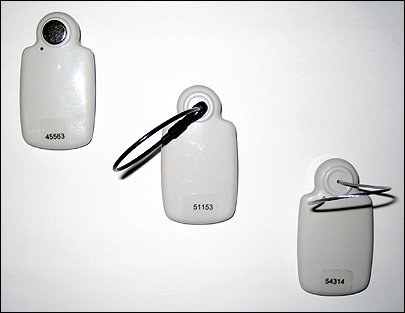Staples Business Depot isn’t new to RFID. Last year, the 270-store Canadian unit of Staples Inc., and a supplier of office products, business machines, office furniture and business services, completed a three-month trial using passive EPC tags for supply chain applications (see Staples Business Depot Sees Big Benefits From RFID Test).
The retailer is now putting a different application to the test: a proprietary RFID system for tracking high-value products inside a large Montreal retail location. The company is in the midst of a six-week trial involving Canadian RFID systems provider AbsoluteSky and Fujitsu Transaction Solutions, a Frisco, Texas, provider of point-of-sale hardware and software systems to retailers.
“Staples has dabbled in passive, and now active,” says Joe Soares, Staples Business Depot’s director of process engineering. “I believe that you need a mix of both to be able to have full coverage of your operations.” Soares says that for supply chain applications, such as tracking the movement of cases and pallets of goods from manufacturing facilities through to stores, passive, disposable EPC tags make the most sense. But for tracking the movement of goods within retail stores—especially those as large as Staples Business Depots—he believes active tags and readers make it easier to pinpoint the locations of specific items.
According to Soares, it is possible Staples Business Depot will eventually employ an EPC-based passive tagging system to track cases and pallets in the supply chain, as well as use active, item-level RFID tags and readers inside its stores. He notes, however, that his company is not using EPC technology today. Though the results of the retailer’s EPC trial showed efficiencies and improvements in data accuracy linked to shipment receipts, Staples Business Depot, he says, is “still evaluating the return on investment [it] can get [from EPC].”
For the current trial, the retailer is using AbsoluteSky’s IntelliTracker tags, readers and software. The system is sold and installed through Fujitsu Transaction Solutions, which began offering RFID integration services early last year (see Fujitsu Offering RFID Services, Readers).
John Frabasile, president of AbsoluteSky, declines to reveal details regarding how the readers determine the tags’ location, nor the specific frequency the tags and readers use, deeming such information proprietary. He explains, however, that the tags—which have an estimated battery life of five years—operate only in one frequency range, and that the readers’ sensitivity is tuned according to their placement and desired read range. For example, interrogators used to locate tags throughout a large area of the store are set to read tags at a greater distance than those employed to search specific areas of the store.
AbsoluteSky developed IntelliTracker to help retailers locate and count tagged items in a store, and to alert staff of both imminent and successful theft of tagged items. This makes the system a potential alternative to the electronic article surveillance (EAS) systems most retailers currently use. When an IntelliTracker interrogator detects a tag within a defined area close to the store exit and reads its unique ID number, the IntelliTracker software compares the number to the IDs of tags attached to items purchased. These ID numbers are collected using very low-range readers stationed at the point of sale, used by sales clerks to read a purchased item’s tag before removing it from the item. The removed tags will later be re-encoded and attached to another item for sale.
If the IntelliTracker system detects a tag that is not associated with a purchased item, it can transmit an alert to store security personnel that a theft is likely in progress. If, on the other hand, the tag detected matches one associated with a recently purchased item, the system presumes it is a tag that a sales clerk neglected to remove and therefore does not send out such an alert.
The IntelliTracker system also tracks tags passing through store exits without being purchased—that is, those attached to goods being stolen—so the retailer can maintain accurate records of stolen goods. “This is helpful information for keeping accurate inventory records,” says Soares, adding that this data is unattainable from current EAS systems, since EAS tags are not product identifiers.
To date, Soares says, 2,000 IntelliTracker tags are in use at the Montreal store on high-value items the managers have deemed likely to be stolen. The tags have a rugged housing and measure 0.25 inch thick, 1 inch long and 1.25 inches wide. As the items are received and brought into store inventory, the tags are attached with loops, pins or another of 10 different attachment methods AbsoluteSky has devised. Store personnel use readers linked to a server running the IntelliTracker software, to encode a unique ID to the tag associated with the item’s stock-keeping unit and Universal Product Code.
According to Frabasile, the IntelliTracker software is installed on a PDA device that store personnel can use to locate a product type—such as a specific printer cartridge SKU, for example—to determine the quantity of that item available in the store at that time, as well as the closest location of such an item. The PDA also includes an RFID interrogator that can be used to hunt down a specific IntelliTracker tag within a store, by emitting a beeping sound as the user gets closer to the tag.
Soares says Staples Business Depot plans to analyze the trial results to determine whether it will conduct more tests of the technology or perform another, larger test. One important metric the retailer plans to track, he explains, is the number of times it uses each tag (that is, how many times each tag is removed from a product at the point of purchase, then re-encoded and attached to another product). This will enable it to estimate the per-use cost of the tags during their five-year life span.
So far, Soares says, the tags are showing strong performance. “We’ve been getting 100 percent reads from day one.”


